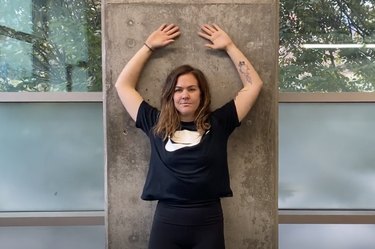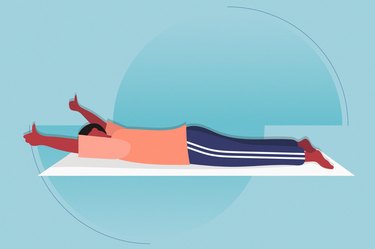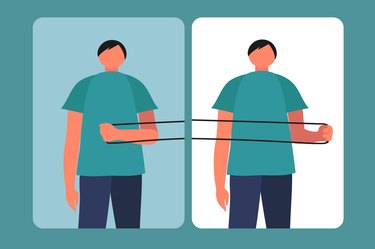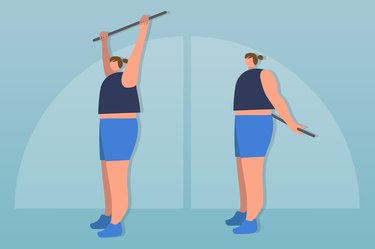

All those snow angels you made as a kid have prepared you for this exercise — well, kind of. The wall angel exercise, while channeling your inner child, takes your upper-back and shoulder mobility to the next level.
Despite its simplistic look, this move is deceivingly challenging. So before you try it out, read on to perfect your form and learn all of the benefits this move has to offer.
Video of the Day
- What's a wall angel? It's a shoulder exercise that involves standing against a wall and raising your arms overhead in an arcing motion, much like making a snow angel.
- What are the main wall angel muscles worked? This move mainly targets your shoulders, the rotator cuff muscles, your traps and your back, according to Melissa Garcia, DPT, CSCS, a Washington-based physical therapist and strength coach.
- Who can do wall angels? They are safe for anyone that has pain-free motion in their shoulders. And while they are a very common rehab exercise, anyone with an existing shoulder injury or back pain should talk with their physical therapist before trying any new exercises.
How to Do Wall Angels With Perfect Form
Wall Angel
- Stand against a wall with your feet hip-width apart and a small bend in your knees.
- Tuck your tailbone to press your lower back as close to the wall as possible, and tuck your chin.
- Bring your elbows out to your sides in line with your shoulders, elbows bent to 90 degrees, and the backs of your hands facing away from the wall. All should be in contact with the wall.
- Keeping your hips, back, head, and arms against the wall, slide your arms up the wall as far as comfortable.
- Pause, then reverse the motion to return to the starting position.
Tip
The key to this exercise is keeping your back and head pressed against the wall the entire time you do this move, Garcia says.
If you struggle to reach all the way overhead and maintain good form, shorten your range of motion, reaching only as far as you can.
Why Do Wall Angels Feel So Hard?
Reaching your arms overhead demands a lot of upper-back and shoulder mobility.
Think of this mobility as a combination of flexibility, strength and muscular control. And all three of these are things we tend to lack.
After all, most people spend their days sitting at a desk or hunched over their phones, which can result in poor posture. When your spine and shoulders aren't used to optimal positioning, it can become difficult for your shoulder blades to move properly against the back of your ribcage, according to the American Council on Exercise (ACE).
And if you don't train your rotator cuff muscles regularly — like with this strengthener — it's easy to lack the muscular strength and control to combat a mobility-limiting lifestyle. Your rotator cuff muscles are small tissues that stabilize and control the shoulder blades (aka scapulae). They need ultimate precision to do their thing, and include the subscapularis, infraspinatus, supraspinatus and teres minor.
If you struggle with the move, don't sweat it. It just means you need the exercise that much more. Keep at it, and in time, it will become easier.
3 Ways to Get More From the Move
1. Tuck Your Chin
When you do this exercise, you want your head to stay pressed against the wall the entire time, Garcia says. But it's possible that, if you're lacking some shoulder mobility, you may feel your head float forward off the wall.
If that happens to you, tuck your chin a bit to keep the back of your neck long, she recommends. Keep your eyes forward and try the move again.
2. Don't Arch Your Back
Like your head, your middle and lower back may have a tendency to come off the wall as you do this exercise, according to Garcia. This defeats the purpose of the exercise, though.
Try tucking your tailbone to press your back into the wall, she suggests. Brace your core, then hold this position throughout the entire move.
3. If Needed, Hold Your Arms Off the Wall
Wall angels demand a lot of mobility, and as you've read, many people can't get their arms up the wall without arching their back
If that's the case for you, bring your arms an inch or two off the wall, Garcia says. This will reduce the mobility demands of the exercise and help you build up an arms-against-the-wall position.
With this move, keeping your back flat is the first priority. Keeping your arms against the wall is secondary.
3 Wall Angel Exercise Benefits
1. Better Posture
This exercise helps undo a lot of the negative postural effects of day-to-day life, Garcia says. Sitting at a desk, hunching over a phone or bending over a steering wheel can throw off your spinal posture and lead to weakening of the middle- and upper-back muscles.
The standing wall angel exercise works a lot of the supporting muscles in your back, like your traps (upper back), your serratus anterior (sides of your ribs) and your rotator cuff (shoulder blades), Garcia says.
When doing wall angels for posture, know that this move also builds your core strength — another big player in good posture, she says. The muscles in your deep core work like a weight belt, giving your spine extra support.
2. Healthier Shoulders
For a lot of people, straightening their arms overhead is no easy feat. But it's a move most people try to do in their daily activities, like lifting a box overhead or putting on a sweatshirt. That's why it's so important to practice this motion in your workouts, Garcia says.
Many people experience pain or pinching in their shoulder joints, Garcia says. This exercise is a safe way to relieve pain and improve stability in these joints.
3. A More Open Chest
Sure, it's primarily a scapular exercise, bit it's also an underrated chest-opening exercise. After all, when you press your arms and back into the wall, you're gently stretching your pectoral muscles.
This stretch can feel great as well as promote better posture, Garcia says.
2 Wall Angel Variations
Move 1: Floor Angel
- Lie on the floor with your knees bent and feet flat.
- Position your arms out to your sides like a cactus.
- Keeping a bend in your elbows, move your arms against the floor and overhead as far as comfortable.
- Reverse this motion to return to the starting position.
Tip
Beginners can benefit from doing wall angels on the floor. With this modification, though, it's still important to keep your tailbone tucked and bore braced. Garcia says. Ideally, there should be no space between your lower back and the floor.
Move 2: Seated Wall Angel
- Sit against a wall with your shoulders, back and head flat against the wall.
- Bend your knees and ground your heels into the ground.
- Hold your arms out to your sides like a cactus.
- Keeping a bend in your elbows, move your arms overhead as far as comfortable.
- Reverse this motion to return to the starting position.
Tip
This modification is a great option for people who prefer to stay in a seated position. If you don't wan't to or don't have the ability to get down on the floor, you can also do this exercise seated in a chair.
That said, it isn't necessarily any easier than the regular move. You could consider this a wall angel progression because it forces you to keep your back in contact with the wall. No cheating, here!
More Exercises for Shoulder Health
Was this article helpful?
150 Characters Max
0/150
Thank you for sharing!
Thank you for your feedback!



